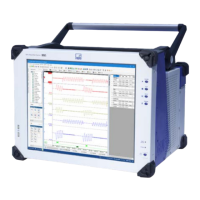GEN7iB
290
GEN series SYNCHRONIZATION METHODS
GEN series SYNCHRONIZATION METHODS
14
14.2.5 Transparent clock switch synchronization
The operation of PTP relies on a measurement of the communication path delay
between the time source, referred to as a master, and the receiver, referred to as a
slave. This process involves a message transaction between the master and slave
where the precise moments of transmit and receive are measured - preferably at the
hardware level. Messages containing current time information are adjusted to account
for their path delay, therefore providing a more accurate representation of the time
information conveyed. The path delay measurement process of PTP involves the
precision timing of two messages - a sync message and a delay request. The average
path delay of the two messages gives the one-way delay. This, however, assumes that
the communication path is completely symmetric. This assumption does not hold
in a switched network, however, largely due to the buffering process within Ethernet
switches. PTP allows transparent clocks to measure and account for this delay in a
time-intervaleldwithintimingpackets,thusmakingtheswitchestemporarytranspar-
ent to master and slave nodes. Transparent clocks must perform this operation very
accurately and at the communication speed without introducing more delays. The End-
to-End transparent clock forwards all messages just as a normal switch does.
Message-based synchronization
PTP is based upon the transfer of network datagrams to determine system properties
and to convey time information. A delay measurement principle is used to determine
path delay, which is then accounted for in the adjustment of local clocks. At start-up,
a master/slave hierarchy is created using what is called the Best Master Clock (BMC)
algorithm to determine which clock has the best source of time. The BMC algorithm is
thenruncontinuouslytoquicklyadjustforchangesinnetworkconguration.Syn-
chronization is achieved using a series of message transactions between master and
slaves.Therearevemessagetypes-Sync,DelayRequest,FollowUp,DelayResponse
and Management - which are used for all aspects of the protocol. A sequence of mes-
sage transactions takes place to synchronize a pair of clocks as shown in Fig. 14.9.

